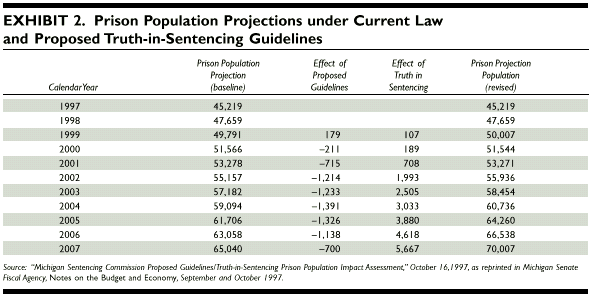Introduction
In the past Michigan like any other American state has always given its prisoners time credits, which primarily depend on prisoners’ behavior during jail terms. It gave the majority of these time credits on a continuous basis, whereby the number of credits increased progressively as one spent more time in prison. However, this practice never lasted for long because of many changes that the judicial system has undergone. For example in 1978, Michigan adopted ballot proposal B, which sought to remove giving credits on minimum sentence. In 1982, due to the negative impacts of the proposal, the state re-introduced the credit awarding system, which primarily helped to reduce the number of years prisoners spent behind bars. However, this too never lasted for long due to the adoption of the truth in sentencing law in the early 1990s. (Brown p.2
The “Truth in Sentencing” Law
The federal government introduced the truth in sentencing law in the early 1990s, whereby it advocated for all prisoners with serious offenses to spend 85% of their jail term behind bars. In 1998, Michigan introduced in its corrective centers another version of the truth in sentencing law, which was a little bit different from the original version. The law recommended that all prisoners are to serve their whole jail term behind bars, whereby it abolished all credits on well-behaved prisoners. Such credits were important because they helped in reducing the amounts of jail terms individuals spent behind bars, hence reducing over-crowdedness in prisons.
Impact of the various credit schemes on individuals
Minimum number of years prisoners should serve under various credit schemes
Truth-in-.

In addition, the law directed that all offenders serving minimum jail terms should complete them before parole boards consider their paroles. In addition, corrective centers should not include disciplinary time directly to normal minimum jail sentence offenders, but rather the state-directed that parole boards should take into consideration all time spent behind bars by specific prisoners (Department of corrections Para. 1-2).
The second section of the Michigan Truth in sentencing law directed that all offenders should spend their jail terms in corrective centers with enough security. This has led to the elimination of the previously used prisoner transitional system, whereby the states allowed offenders whose parole dates were near to join communal activities as they complete their jail terms. Primarily this has contributed to the reduction of numbers of individuals who are joining community residential programs (CPR), which was the main transition methodology for prisoners back to the community.

The state passed this law in order to eliminate looming corruption, which had affected the correct functioning of correction systems in Michigan. To ensure the law worked effectively, Michigan’s judicial system enacted guidelines to which law-enforcers were to use in ensuring their practices followed correct criminology ethics when handling criminal offenses (Burdick Para. 4-6).
Impacts of the Law on Prisons
Due to the new law, there has been continuous growth of prisoner numbers both with minimum and maximum jail terms. For example between 1997 and 2007, the prison population increased from 45,219 to 65,040, and since then the figures have increased making the state use more resources on correction centers than it uses on all its higher learning institutions (National criminal reference services Para. 1-7). Controlling such increasing populations has been the main challenge for prison authorities. The majority of offenders serving long terms are major security threats in prisons in that
they know their jail term cannot be reduced nor be cut short by any credits, hence the need to amend the law. On the other hand, many prisons face expansion challenges due to escalating expenditures on prisoner needs, hence the deteriorating prison standards. Research shows that Michigan’s prison expenses almost amount to $ 1.9 billion, which makes it the most expensive of all corrective centers in the U.S. (Topix para.1)

Impacts on state budget
Due to the removal of credits awarded to prisoners, there has been an influx in the number of prisoners in prisons, hence the need for continuous state spending to meet their needs. Research conducted by the U.S. justice system in 1997 found that almost 1.7 million offenders were in prison, whereby Michigan only accounted for almost 45, 426 prisoners. This has made the state expand its prisons to accommodate the ever-increasing numbers of prisoners. For example, research shows that Michigan has set up more than eleven new correction centers in the recent past, which almost accounts for $ 1.3 billion of its annual budget. Corrective centers use the majority of these funds to increase bed space and other basic essentials for prisoners.
Conclusion
In conclusion, the abolishment of the credit system has had minimal effect on security in the majority of Michigan’s corrective centers. For the state to ensure its prisons are safe, then the state must consider many factors, in order to avert criminal activities in prisons. The state should convert the Majority of revenue spent on prisoners to assist Michigan citizens who are currently facing high unemployment and poverty problems. In this regard, the U.S. government should do a critical analysis of Michigan’s judicial system to make sure the state overhauls it, hence adopting a system that serves its communities’ wider needs. The state should give prisoners with good behavior incentives, and if possible, the states should adopt better incarceration methods for their prisoners (Petition spot Para. 1-3)
Works Cited
Brown, Robert. Re-assessing « truth in sentencing: the impact of eliminating disciplinary credits and community residential programs, 2008. Web.
Burdick, Larry. Prosecuting attorneys for Isabella country. The Morning sun, Web.
Department of corrections. How do I learn about truth in sentencing? Department of corrections Michigan, 2009. Web.
National criminal justice reference services. Corrections. Public sector consultants. 2008. Web.
Petition spot. Enact Michigan house bills 5129, 5130, 5131. Petition spot. 2006. Web.
Topix. Truth in sentencing in Michigan prisons. Topix. 2009. Web.